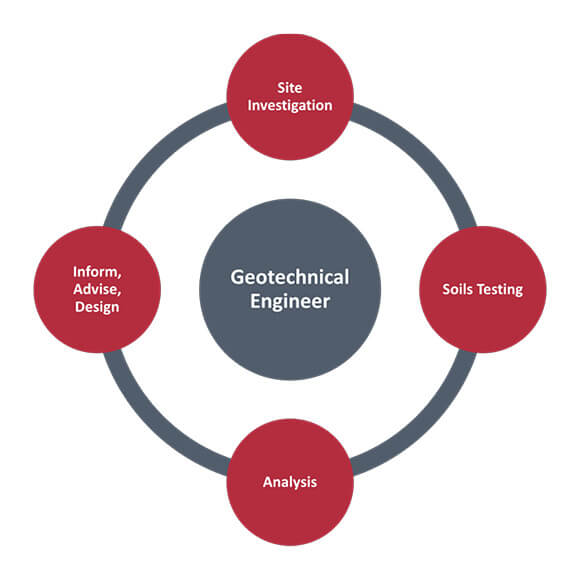The 7-Second Trick For Geotheta
The 7-Second Trick For Geotheta
Blog Article
The Only Guide for Geotheta
Table of ContentsSome Known Facts About Geotheta.More About GeothetaWhat Does Geotheta Do?Fascination About Geotheta
They work together with civil designers, structural engineers, architects, and other professionals to integrate geotechnical considerations into the general task layout and building process. This calls for effective teamwork, coordination, and communication to ensure that the geotechnical aspects line up with the job purposes and meet regulative needs.Mining & Products Engineering: Concepts of drilling, infiltration rates, and elements affecting the option of exploration technique. Features of dynamites, shooting systems and blast patterns. Blowing up methods in surface and below ground functions. Unique blasting methods at excavation borders. Resonance and noise control. Mechanical and continuous strategies to fragmentation, including longwall shearing and fullface boring.
Integrated evaluation of fragmentation and comminution procedures. Supplied by: Mining & Materials Engineering.
Indicators on Geotheta You Need To Know
Bachelor's degree programs in civil, geotechnical, geological, and environmental design usually last four years and include basic education programs in English, social scientific research, and the liberal arts, along with programs in advanced mathematics, architectural geology, and liquid mineralogy. (https://pxhere.com/en/photographer/4325446)
Geotechnical design entails the evaluation of the soil and rock conditions at a specific site, and their implications for the advancement of that website. As the majority of frameworks count on the ground for support, it is without surprise that a comprehensive understanding of the ground problems, and the viability of foundation systems, are vital to the lasting stability and efficiency of the structure or framework.
Being experts in the investigation of geological developments and ground behaviour, geotechnical engineers carry out scientific examinations and testing to understand the effect these geological developments may have on the style and building of building, civil and infrastructure jobs. This expertise is vital for the design and construction of buildings, roadways, tunnels, dams, bridges, and water system and sewage systems.
The geotechnical team at Douglas Partners regularly consult with engineers, design designers, programmers, and building contractors to make suggestions on style and development proposals to ensure that the constructed structures are accordingly designed for the ground conditions. The design of footing systems needs to take into consideration the weight of the structure, the capability of the ground to sustain that weight with each other with activity tolerances and reliable building.
A Biased View of Geotheta
This job is greatly simplified by the use our Douglas Map geospatial system that makes this details conveniently easily accessible in a simple to make use of internet internet browser user interface. A geotechnical engineer will direct the drilling of boreholes and examination pits to accumulate dirt and other examples, and additionally evaluate surface functions and ground direct exposures to create a geotechnical version of the subsurface problems.
Depending upon the job kind and ground problems encountered, right here research laboratory screening may among other things analyze stamina, compressibility, reactivity and/or leaks in the structure of soil and rock examples. After this data is gathered and collated, the results are utilized for a geotechnical model of the site, which is commonly presented as sections throughout the site.

A geotechnical investigation naturally can just evaluate the ground conditions at the places drilled or dug deep into. All-natural variations in soil and rock problems can occur across a website and in between examination places. It is for that reason excellent method that the geotechnical designer be retained throughout construction of the job to supply on-site confirmation that the ground conditions encountered are consistent with the expectations and guidance provided in the geotechnical investigation record.
How Geotheta can Save You Time, Stress, and Money.
Geotechnical designers utilize their extensive knowledge of soil and rock to assess threat and fix issues on varied infrastructure projectsGeotechnical design is a specialist branch of civil design which checks out the practices of earth products and the application of dirt and rock technicians. Geo Tech Engineering. As a geotechnical designer, you will analyze the physical, mechanical and chemical properties of dirt and rock in order to design structures, maintaining frameworks and earthworks
Geotechnical design is closely linked to and overlaps with, both design geology and ground design - https://www.behance.net/ianhammond2. It's possible to specialise in geotechnics or help a geotechnical company yet be called a design geologist or a ground engineer. As a geotechnical designer, you'll require to: construct and preserve partnerships with customers and various other specialists associated with the website, throughout each projectmaintain security requirements on site bear in mind expense implications when you make recommendationsstudy geological maps and aerial photos from a series of sources and from various time periodsexamine building and construction prepares to see how viable they are based on your understanding of the siteinvestigate dangers or geological dangers for the sitesearch for environmentally delicate attributes, such as garbage dump begin to create valid and expository ground modelsplan field investigationsdrill and evaluate examples of bedrock, dirt, groundwater and additional products monitor other specialists on sitesolve technological issues as they arise, such as unexpected structures at drill sitesmonitor problems throughout and after building and construction to make certain frameworks are stable in the short and lengthy termadding information accumulated on website to your first researchcreating geotechnical computations, drawings, and 2 or three-dimensional computer system versions translating the datamaking referrals regarding the recommended use of the site

Report this page